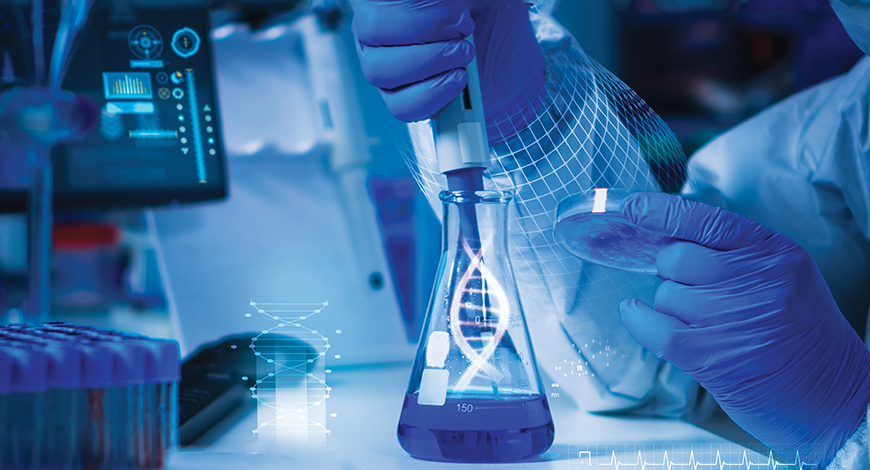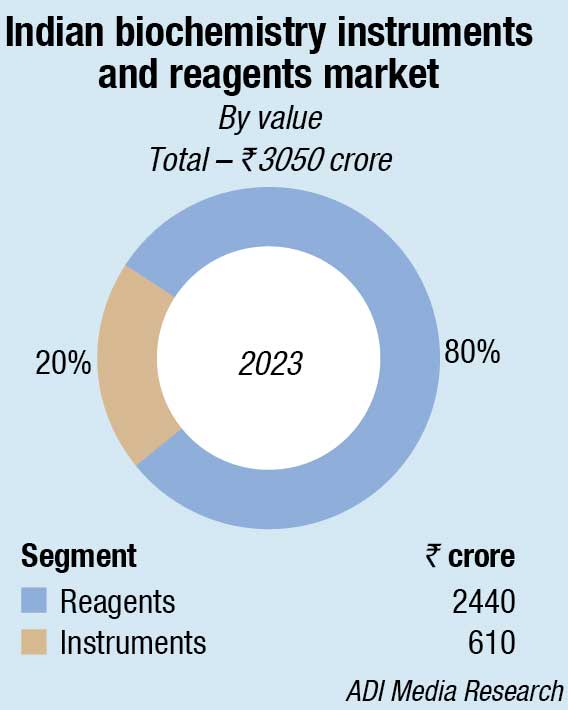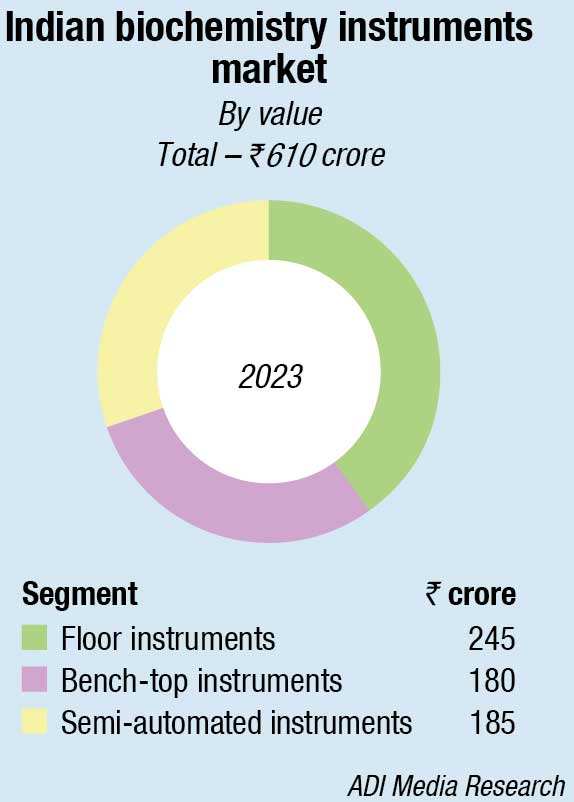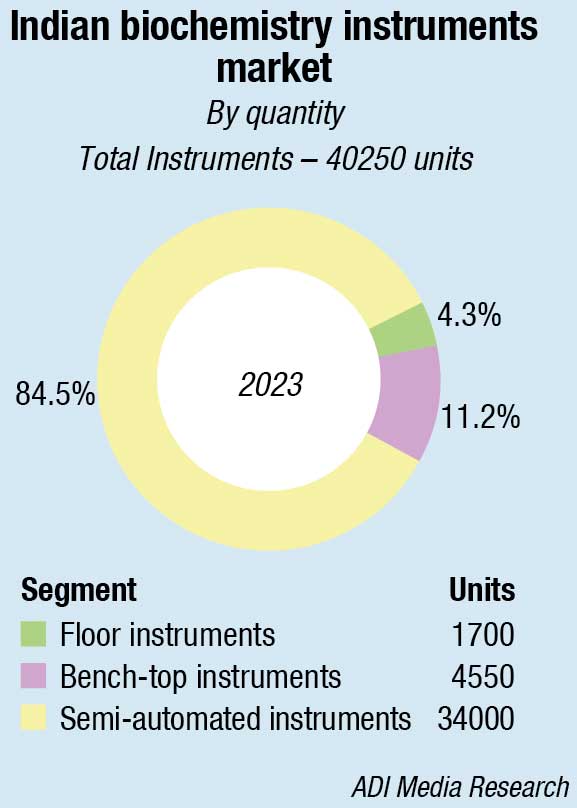Biochemistry Instruments and Reagents
Biochemistry market–Characterized by continuous innovation

Embarking on a relentless ascent, biochemistry analyzers and reagents with enhanced properties are regularly introduced, expanding the range of possibilities for researchers and diagnosticians.
The trajectory of biochemistry analyzers, marked by an unstoppable rise, has traversed significant milestones in the last few decades. The swift pace of technological advancement, a driving force behind this evolution, is poised to catalyze even further enhancements. The current determinants influencing development are expected to usher in transformative changes in the future, coupled with unforeseen drivers.
Harvard biochemist Otto Folin laid the groundwork for clinical biochemistry in the United States during the twentieth century. The era post-World War-II witnessed the advent of groundbreaking products like radioimmunoassay and the autoanalyzer between 1948 and 1960, marking what could be deemed the golden age of clinical chemistry. This period saw the quantitative analysis of blood and urine, employing instrumentation, in the application to human disease and health.
Over the last 80 years, clinical chemistry has assumed a pivotal role in deciphering the structures and chemical reactivity of the fundamental building blocks utilized by all organisms. It has provided the molecular framework for understanding the pathways inherent in central metabolism. The recent pandemic played a pivotal role in propelling the growth of biochemistry, intensifying the demand for specific parameters, such as LDH, ferritin, D-Dimer, and CRP while concurrently reducing manual interventions. Diagnostic companies are actively developing test kits exhibiting significant cross-platform correlation, with clinical chemistry platforms remaining the preferred choice due to their technical superiority.
Technological advancements and emerging trends on biochemistry instruments and reagents
 Thomas John
Thomas John
Managing Director,
Agappe Diagnostics Ltd
Biochemistry is the application of chemistry to the study of biological processes at the cellular and molecular levels, for the analysis of cells, blood, and other body fluids for their chemical, biochemical and hormonal components, using samples of serum, plasma, and urine.
Initially, biochemical analysis was based on the colorimetry where the absorbance was measured to assess the concentration of the solution. The monochromator used in the earlier colorimeters were coloured glass. Subsequently, filter-based photometry was employed, whereby the interference filter replaced the coloured glass in the analysers, for precise wavelength selection and better accuracy. Grating Photometry is the present tool for automation, precision and accuracy. Dependable results are guaranteed with this for special parameters as well as for the routine tests like Lipids, LFT & RFT etc.
There are multiple advanced features available in the Grating photometry system which is giving an upper hand as compared to normal interference photometry. Grating technology provides a linear dispersion of wavelength, reduce the absorption effects, a greater number of perfect wavelengths, long lifespan and minimal maintenance.
From the market analysis of the last few years, it is evident that the labs that are upgrading to fully automation has increased more than 30 percent for more reliability and better accuracy. World over, patients are more cautious about reliable results and time.
Fully automation instrument is one of the mandatory requirements in any laboratory which will reduce the TAT even with handling a greater number of samples accurately. The Auto reflex function in automated instrument will help in providing results faster and provide adequate support further.
With the advancement of AI in Clinical chemistry in the very near future can fulfil the requirements of current Alpha and upcoming Beta generations with more rapid and accurate results.
Agappe, your best partner in diagnostics, has a range of Fully Automatic Biochemistry analyzers like TBA-120FR, TBA-2000FR, Mispa CXL Pro Plus, Mispa Nano Plus and Biolis 30i for different kind of workload customers. Agappe offers fully automated clinical chemistry analyser at best affordable price along with best quality.
Manufacturers now offer a spectrum of features in their respective automated analyzers, providing numerous benefits for error-free reporting, amplifying test volumes, and positively impacting patient safety. Consequently, laboratories are expanding their operations by diversifying menus, establishing new branches, and forming collaborations with existing market leaders, generating a substantial demand for automation. From small-scale to high-end laboratories, encompassing private and public sector hospitals, the call for automation is resounding, and is poised for exponential growth in the future.
The journey of biochemistry analyzers is not a zero-sum game; rather, it embodies an unstoppable ascent. As we witness this evolution, characterized by innovation and breakthroughs, we find ourselves on the threshold of a future where diagnostics transcend mere accuracy, becoming universally beneficial. The symphony of progress orchestrated by biochemistry analyzers is a testament to the relentless human spirit, ceaselessly pushing boundaries and reshaping possibilities in healthcare.
Navigating the future – Technological innovations in biochemistry instruments and reagents
 Gaurav Bhide
Gaurav Bhide
Product Manager – Biochemistry,
Transasia Bio-Medicals Ltd
The biochemistry segment is heralding a new era marked by enhanced accuracy, precision, and increased diagnostic capabilities. This has led to a heightened demand for mid-segment throughput analyzers with advanced features, such as clot detection. Further, an increase in workload in Tier-II and Tier-III cities has led to a shift from semi-automated analyzers (SAA) to fully automated analyzers (FAA). Sophisticated automation also plays a pivotal role in bringing high-end features to small footprint analyzers. Today with turnaround time (TAT) playing a crucial role in high workload labs, autoloader is the best suitable option, as it offers continuous loading facility, thereby making it a true walk-away system.
Artificial intelligence (AI) and machine learning (ML) are transformative forces in the in vitro diagnostics (IVD) Industry, enhancing the accuracy and efficiency of diagnostic tests. These technologies can add more valuable features in a biochemistry analyzer, such as reflex testing, which can help labs and assist clinicians with interpretation of results, and aid in further disease management in patients. While serum indices identification is a crucial AI function for accurate reporting in FAAs, the Internet-of-Things (IoT) is one of the futuristic must-have features in FAA. Automation combined with AI and cloud-based technologies reduces downtime of the instrument drastically by offering remote service facility.
Miniaturization and microfluidics technologies are reducing the size of instruments, exemplified by the shift from conventional electrode-based ISE analyzers to microchip-based potentiometers integrated into biochemistry analyzers, offering a modular approach.
In line with initiatives for a Cleaner and Greener India, embracing permanent hard-glass cuvettes over disposable plastic cuvettes, not only contributes to environmental health but also makes solutions more affordable.
Further, ground-breaking innovation in biochemistry reagents includes liquid-stable formulations that are ready-to-use and meticulously crafted for seamless compatibility with biochemistry analyzers. Offered in convenient pack sizes, and engineered with well-defined performance characteristics, these reagents boast heightened linearity, sensitivity, and precision, setting a new standard in diagnostic accuracy.
As 2024 unfolds, we at Transasia Bio-Medicals Ltd. continue to set the standard for excellence in diagnostics, reflecting a commitment to innovation, accessibility, affordability, reliability and a vision that paves the way for a healthier and happier world.
Indian market dynamics
In 2023, the Indian biochemistry instruments and reagents market is estimated at ₹3050 crore, with reagents continuing to dominate at ₹2440 crore. With consolidation in the lab industry, some of the stand-alone centers finding it no longer a financially viable business, and the larger chains looking to expand their network to Tier-II, Tier-III, and Tier-IV cities, the vendors are finding a distinct shift in the business model. Margins from the larger lab chains are being compromised, and the payment terms too are not always favorable. With distributors the realization was almost immediate.

Also, the fully automated instruments hugely remain on rentals. Of course, MNCs as Roche, OCD, and Beckman Coulter focus on reagent sales, their basket comprising 70 percent reagents and 30 percent instruments, while for the other players the ratio is almost reversed.

The lab chains are facing serious competition from B2B chain laboratories as Redcliffe and Marvel that offer partnership to smaller labs within a specified radius and a platform to conduct tests on their behalf at very competitive pricing. The number of daily tests done are relatively large and the huge discounts demanded from the vendors cannot be ignored.

Increasingly the bench-top models are preferred by the satellite centers over their floor counterparts. The semi-automated instruments are facing stagnant demand and not commanding good prices for the vendors as the prices per milliliter are declining.
|
Leading players – Indian biochemistry instruments and reagents market-2023 |
|||
| Fully automated instruments | Semi- automated instruments | Reagents | |
| Tier 1 | Transasia and Mindray | Mindray and Transasia | Transasia, Roche, Beckman Coulter, Siemens, OCD, and Mindray |
| Tier 2 | OCD, POCT, Agappe, Snibe and Roche | Rapid | Randox, Agappe and Accurex |
| Tier 3 | Biosystems, Beckman, Abbott, Thermo Fisher, Siemens and CPC | Agappe, URIT, CPC, Biosystems, Accurex, Tulip, Microlab, Beacon, and regional brands | URIT, Abbott, Biosystems, Fuji, Rapid, Beacon, Avantor, AGD, CPC, POCT, Biogene, and local brands |
| Others | Trivitron, Sysmex, Tulip, Biosystems, Accurex (Dirui), AGD, and Randox | ||
| *Vendors are placed in different tiers on the basis of their sales contribution to the overall revenues of the Indian biochemistry instruments market.
ADI Media Research |
|||
The government remains a discerning buyer, and is also increasingly displaying preference for rentals over outright sales.
Anticipations in biochemical diagnostic development
 Isha Sharma
Isha Sharma
Marketing Manager,
Snibe India
Nowadays, the laboratories in India encounter numerous challenges, including the need for quicker turnaround times, enhanced reporting quality, improved service to clinicians and hospitals, and greater affordability of biochemical diagnosis. In the Indian IVD market, the field of biochemistry continues to hold a dominant position. According to recent reports, biochemistry field currently accounts for at least 35 percent of the entire Indian IVD market, significantly surpassing other sectors. Addressing the demand for biochemical diagnosis necessitates technological advancement.
Automating the analyzer will contribute to the reduction of labor and time costs, thereby significantly enhancing testing efficiency. This will alleviate the pressure and tedious work stemming from the high demand for testing in laboratories and hospitals. The implementation of automated technology will also increase the affordability of biochemical testing, enabling more patients to access these diagnostic services.
Fully automated biochemistry analyzers are essential for high-throughput clinical laboratories. The ability to accurately test a large number of samples in the TAT is crucial. Therefore, an automated reagents and samples continuous loading/unloading technology, with whole blood HbA1C testing capability, represents the optimal solution for achieving a higher volume of walk-away tests. This will markedly decrease manual involvement, providing laboratory technicians and doctors with additional time to finish other tasks, rather than having to remain in the laboratory awaiting test results.
In the future, biochemistry analyzers will be enhanced by artificial intelligence (AI) feature automatic error correction, automatic retesting functions, and analysis of results, which can prevent errors caused by manual operation and reduce inaccuracies in test results due to improper handling. Conversational remote human-machine interaction technology allows doctors to remotely access test results and data, monitor instrument status, and control instruments.
The integration of AI technology with the current mainstream IoT facilities and LIS used in laboratories and hospitals will be one of the future directions of technological development. Cloud-based computing and storage databases, combined with AI, can make laboratory data management systems more intelligent, facilitating convenient access to patient data and continuous monitoring of patients’ test results.
The current leading IVD manufacturers, such as Roche, Siemens, Snibe, and Mindray have all begun to lay the groundwork for innovation in biochemistry analyzers. It is believed that these cutting-edge technologies will soon come to fruition.
Global market scenario
The global biochemistry analyzers market size is estimated at USD 4.48 billion in 2023, projected to hit USD 6.58 billion by 2030, at a CAGR of 5.63 percent during 2023–2030, according to 360i Research.
The continuous development of automated biochemical analyzers that assist in analyzing various biochemical components, such as protein, enzymes, drugs of abuse, electrolytes, and metabolite can take the credit for growth. Also, the increasing number of chronic diseases, such as diabetes, decentralization of diagnostics services, increase in demand for POC solutions, and the rising investment in healthcare infrastructure in emerging markets provide impetus.
Automation in biochemistry, the way forward
 Shobhit Jain
Shobhit Jain
Sr Manager, Product – Clinical Chemistry, Urinalysis, Marketing Events and Branding Marketing,
Sysmex India Pvt Ltd
Clinical chemistry Indian market is continuously growing since last few years, and will keep the pace in future too as there are increasing healthcare awareness, acquisition and mergers, introduction of new tests, growth in non-communicable diseases and chronic diseases, aging population, increased focus on preventive medicine, preference for evidence-based treatment, increasing insurance cover, increasing number of lifestyle diseases, government’s initiatives and spending on healthcare, improving healthcare infrastructure, and accreditation.
The biochemistry market in India was the second-largest segment in Indian IVD and in 2022, the Indian biochemistry instruments and reagents market is estimated at ₹2699 crore, with reagents continuing to dominate at ₹2220 crore at 83-percent market share. This is an 11-percent increase by value and a 17-percent increase by quantity, over 2021. Momentum in sales is expected to be maintained for the next five years.
Demand for the fully automation biochemistry analyzers and good-quality clinical chemistry reagents has risen as present trend is to make laboratories more quality conscious by seeking accreditations like NABL (National Accreditation Board for Testing and Calibration Laboratories) and once these norms are followed, one can be assured of the quality of reports. So, under the NABL norms, the demand for biochemistry instruments is growing, as labs are required to have a backup instrument ready.
Sysmex is committed to the mission shaping the advancement of healthcare, and continuously providing total diagnostic solution in hematology, hemostasis, urinalysis, immunoassay, flow cytometry, life science, and clinical chemistry with its presence in more than 150 countries. Sysmex is the market leader in hematology, coagulation, and urinalysis automation worldwide, and has now started to facilitate growing clinical chemistry market as well.
For clinical chemistry reagents and instruments, Symex has introduced BX series fully automated clinical chemistry analyzers, including BX3010 and BX4000, for low-end and mid-end workloads with state-of-the-art technology. BX3010 has a unique ability to perform onboard hemolyzing for HbA1c testing, which eliminates pre-analytical variables (human and pipetting) for sample pretreatment. BX3010 and BX 4000 have clot detection in sample arm, crash detection, and liquid level sensing in reagent/sample arm, 5-speed mixing, and pre-cooled reagent carrousel, which facilitate to avoid carry over, high reagent stability, generate high-quality results, and make it a true walk away system.
Moreover, the rising advancements in technology, a surge in research and development investments, and improvements in novel products using the latest technology, along with advances in medical infrastructure, are propelling the market.
Technological advances have resulted in biochemistry analyzers becoming faster and smaller. The rising availability of portable and smaller biochemistry analyzers has made it possible for physicians to set up their point-of-care diagnostic centers instead of sending the samples to large labs.
The major restraint of the market is high capital cost of the machines, reduction in insurance reimbursement in some regions, and shortage of skilled labor for managing the analyzers as they have complex system integration that hinders market growth.
Regional insights. North America dominated the overall industry and accounted for the largest market share of 35.1 percent. Europe follows closely, with a significant market share attributed to favorable government initiatives, rising healthcare expenditure, and a large geriatric population. The Asia-Pacific region is expected to witness the fastest growth due to improving healthcare infrastructure, expanding patient pool, and increasing healthcare spending in China and India.
Biochemistry analyzers have become indispensable tools, driving advancements that extend beyond conventional boundaries and cutting-edge technologies shaping the field of biochemistry analysis.
The semi-automated analyzers, employed for swiftly determining chemical concentrations in body fluids, aids in diagnosing various health conditions. Researchers have explored utilizing an FPGA evaluation board for its re-programmability, low-power consumption, and high performance in the overall system based on absorbance transmittance photometry principles.
Dry chemistry analyzers have become integral in clinical chemistry, revolutionizing diagnostic processes with their efficiency and versatility, and are poised for substantial growth. These analyzers offer a distinctive approach, enabling rapid and accurate biochemical analyses without the need for liquid reagents, making them particularly suitable for point-of-care testing. The convenience and cost-effectiveness of these analyzers are driving their adoption.
Multidimensional nature of biochemistry
The field of biochemistry analysis is characterized by continuous innovation. The use of sophisticated equipment provides more tests that can be performed on a single sample with high levels of accuracy. This translates not only into more accuracy in the results, but also in the reduction in the time to obtain the results.
In modern times, innovation in reagents remains an important area for biochemistry laboratories, and the reagents market is growing at a significant rate. The innovation in laboratory reagents using imaging technology for diagnosis contributes to early diagnosis, optimal treatment outcomes, and ultimately to the reduction of costs associated with research into these diseases.
Laboratory reagents can now be automatically labelled for more accurate test results with the introduction of computer equipment. The implementation of this process significantly reduces human errors and allows laboratories to reduce reporting times of results.
Integration of IoT
A microfluidics-based biochemistry analyzer utilizing colorimetric imaging acquisition and machine-learning algorithms has been developed to simplify whole blood processing and classical biochemical analysis. The device, fabricated using polydimethylsiloxane through soft lithography, significantly reduces incubation time by approximately 80 percent, leading to quicker per-test reaction times and overall analysis processes.
The integration of microfluidics and machine learning enhances portability, lowers costs per test, minimizes reagent and sample consumption, shortens time-to-result, reduces hardware complexity, and offers a smaller analytical footprint. Incorporating the Internet of Things (IoT) enables real-time access to test results for remote counselling. The platform is tested for triglyceride, calcium, and glucose concentration estimation in blood serum. The platform’s advantages make it suitable for practical point-of-care applications, even in low-resource areas, providing a valuable tool for efficient and accessible biochemical blood analysis.
Sensor integration
The integration of advanced sensor technologies into biochemistry analyzers represents a pivotal advancement in the field of diagnostics, revolutionizing the precision, efficiency, and scope of biochemical analysis. Novel sensors are integrated into biochemistry analyzers, specifically focusing on the advancements in electrochemical sensing.
The development of sensors with enhanced capabilities, contributing to more accurate and rapid analysis of biochemical parameters utilizing cutting-edge sensor technologies, have emerged as a promising avenue for elevating the overall performance of biochemistry analyzers.
The evolution of electrolyte analyzers introducing next-generation devices equipped with bio-sensor cartridge technology simplifies clinical analysis. These analyzers leverage advanced sensor components to simplify clinical analysis, streamlining the measurement of electrolytes. The integration of bio-sensor cartridges enhances the efficiency of electrolyte analysis, providing a more user-friendly and adaptable solution for clinical laboratories. This development underscores the pivotal role sensors play in reshaping the landscape of biochemical analysis.
Electrochemical biosensors simplify processes like drug screening, insect capture, and DNA detection. The quantum dot-based biosensors present a novel alternative in diagnostic medicine, leveraging the unique properties of these nanomaterials. Beyond their optical characteristics, quantum dots offer advantages in electrochemical detection, enhancing sensitivity and accuracy in biomolecule detection while reducing analysis time.
Recent years have seen a surge in research on quantum dots, driven by their high quantum yield, stability, and consistent electrochemical characteristics. These biosensors operate electrically, utilizing reactive mediators and various processes like quantum tunneling and electrochemiluminescent events. Applications of quantum dots extend across diverse biochemical detection scenarios, showcasing their potential for accurate and sensitive analyses. The development responds to the need for miniaturization, aiming for faster and cost-effective clinical diagnostic tests, particularly in lab-on-a-chip applications.
Finally, biosensors play a crucial role in diverse medical fields, contributing to disease diagnosis, clinical analysis, and drug discovery. Among these, electrochemical biosensors are widely utilized in clinical and healthcare services due to their small size, cost-effectiveness, and high susceptibility, particularly in multiplex assays. Bibliometric analyses reveal a growing trend in research publications on electrochemical biosensors, highlighting the significance of staying abreast of the latest developments.
Clinical chemistry – The future
 NC Shaji
NC Shaji
General Manager,
Beacon Diagnostics (A Beacon Group Company)
With the majority of clinical decisions relying on diagnostic tests, the responsibility is on clinical laboratories to process a high volume of clinical chemistry tests as efficiently and accurately as possible. This makes clinical chemistry typically the largest-volume category of a laboratory, and is expected to remain so in the future. While novel menu launches in clinical chemistry may not be developing at the same pace as heterogeneous immunoassay, molecular, or next-generation sequencing, R&D activities for product line enhancements, such as more scalable and automated solutions, enhanced connectivity with other platforms, and improved offerings continue for clinical chemistry.
Common automation solutions include random access analyzers that no longer pause when reagents and consumables need to be loaded, as well as automated calibration and quality-control on-board analysis that decrease hands-on time with equipment. More recent advances in instrument technology and engineering have opened the door for sophisticated testing capabilities on chemistry systems, such as consolidating specialty assays into routine chemistry operations and longer, uninterrupted run times to improve testing capacity and efficiency. In future, automation will allow labs to add new technologies into their core labs, including liquid chromatography-tandem mass spectrometry.
The emergence and integration of artificial intelligence (AI) into various facets of clinical chemistry over the past decade have opened exciting opportunities and transformative possibilities in how we practice laboratory medicine. Clinical chemistry, as a specialized field within laboratory medicine, is no exception in this regard. AI and its associated tools have undergone extensive exploration recently to identify novel applications in the everyday practice of clinical chemistry. This pursuit has become even more crucial as the global healthcare landscape continues to adapt to the profound changes brought about by the Covid-19 pandemic, which significantly impacted all aspects of laboratory medicine. AI will help clinicians to move forward with precision-based medicines approach, which will serve in the best interest of the patient.
From the time of its inception, Beacon Group has always considered clinical chemistry as its major product line. Working with the time, the efforts we put forward in offering the solutions are well recognized and appreciated by our customers across the globe.
Electrochemical biosensors find applications in diagnostics, forensics, and health monitoring, with promising advancements in next-generation diagnostics, especially in immunological techniques for precise multiplexing. Notably, the research shows a heightened interest in the detection of biomarkers associated with diseases like cancer using electrochemical biosensors. The bibliometric studies reveal a notable concentration of research efforts in China, the USA, and India, with leading journals and funding sources identified.
Co-occurrence analyses emphasize keywords, such as electrochemical biosensor, biosensor, sensor, nanoparticles, and gold nanoparticles. The analysis further underscores the importance of electrochemical biosensors in healthcare, providing insights into their growth trajectory and offering a valuable foundation for future research and development in this evolving field.
FPGA-powered biochemistry analyzer for precision diagnostics
Building upon the foundations of biochemical analysis, the utilization of colorimetry for measuring absorbance and assessing solution concentration marked a crucial era in laboratory methodologies. This approach, rooted in absorption photometry principles, involves the quantitative estimation of color concentration within the visible spectrum (380–780 nm) for sample solutions, including water and biological samples.
The indispensable instrument for this purpose, known as a colorimeter or absorptiometer, requires substances to exhibit color or possess the ability to form chromogens, absorbing light based on their color intensity. The intensity of the color, thereby, correlates directly with the concentration of the colored compound.
In the contemporary landscape of clinical laboratories, photometric principles continue to be paramount, encompassing the measurement of absorbed, transmitted, or emitted light. Spectrophotometry, extending the scope to measure intensity at different wavelengths across the entire electromagnetic spectrum, exemplifies this approach.
This technological evolution aligns with the broader trend seen in laboratory automation, where complete instrument automation, including features like Auto Reflex functions, expedites turnaround time (TAT) and maintains accuracy across diverse sample volumes. The seamless integration of such features not only enhances operational efficiency but also contributes significantly to the precision of laboratory outcomes.
Taking this trajectory forward, recent research introduces the Fully Automated Biochemical Analyzer (FABCA), a cutting-edge system utilizing FPGA technology and optical methods for the rapid and precise analysis of biological samples. The system encompasses various analytical techniques, including colorimetric, spectrometric, and fluoroscopic detection, seamlessly integrated into a single platform. This not only enables the measurement of various substances in bodily fluids but also positions the analyzer as a versatile tool for medical diagnostics in diverse healthcare settings.
The hardware components, featuring the DE0-Nano board with a Cyclone IV FPGA, OPT101 photodiode, and ADC128S022 analog-to-digital converter, underscore the system’s technological prowess. The study emphasizes the significance of an improved UV anti-reflection coating on optical components, enhancing photodetector response and ultimately contributing to the system’s precision. System design intricacies, such as interfacing ADC with FPGA and implementing Fast Fourier Transform (FFT), are critical components ensuring efficient signal processing. Simulation results, conducted through Xilinx Vivado software, conclusively demonstrate the successful implementation of the designed system.
The relentless evolution of biochemistry analyzers propels us into a future where diagnostic precision transcends limits. With technological strides, from automated systems to innovative nanosensors and advanced reagents, the landscape of healthcare transforms. The synergy of biochemistry analyzers not only ensures accurate diagnoses but also heralds a paradigm where accessibility, efficiency, and rapid advancements define medical practices. The unstoppable rise of biochemistry analyzers foreshadows an era where diagnostics empower a healthier, interconnected, and technologically advanced society.












